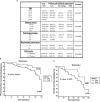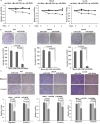Novel tumor suppressor microRNA at frequently deleted chromosomal region 8p21 regulates epidermal growth factor receptor in prostate cancer
- PMID: 27611943
- PMCID: PMC5342560
- DOI: 10.18632/oncotarget.11865
Novel tumor suppressor microRNA at frequently deleted chromosomal region 8p21 regulates epidermal growth factor receptor in prostate cancer
Abstract
Genomic loss of chromosome (chr) 8p21 region, containing prostate-specific NKX3.1 gene, is a frequent alteration of the prostate cancer (PCa) oncogenome. We propose a novel, paradigm shifting hypothesis that this frequently deleted locus is also associated with a cluster of microRNA genes- miR-3622a/b- that are lost in PCa and play an important mechanistic role in progression and metastasis. In this study, we demonstrate the role of miR-3622b in prostate cancer. Expression analyses in a cohort of PCa clinical specimens and cell lines show that miR-3622b expression is frequently lost in prostate cancer. Low miR-3622b expression was found to be associated with tumor progression and poor biochemical recurrence-free survival. Further, our analyses suggest that miR-3622b expression is a promising prostate cancer diagnostic biomarker that exhibits 100% specificity and 66% sensitivity. Restoration of miR-3622b expression in PCa cell lines led to reduced cellular viability, proliferation, invasiveness, migration and increased apoptosis. miR-3622b overexpression in vivo induced regression of established prostate tumor xenografts pointing to its therapeutic potential. Further, we found that miR-3622b directly represses Epidermal Growth Factor Receptor (EGFR). In conclusion, our study suggests that miR-3622b plays a tumor suppressive role and is frequently downregulated in prostate cancer, leading to EGFR upregulation. Importantly, miR-3622b has associated diagnostic, prognostic and therapeutic potential. Considering the association of chr8p21 loss with poor prognosis, our findings are highly significant and support a novel concept that associates a long standing observation of frequent loss of a chromosomal region with a novel miRNA in prostate cancer.
Keywords: EGFR; chr8p21; miR-3622b; prostate cancer; tumor suppressor.
Conflict of interest statement
The authors declare no conflicts of interest.
Figures







Similar articles
-
A novel microRNA regulator of prostate cancer epithelial-mesenchymal transition.Cell Death Differ. 2017 Jul;24(7):1263-1274. doi: 10.1038/cdd.2017.69. Epub 2017 May 12. Cell Death Differ. 2017. PMID: 28498363 Free PMC article.
-
Role of a novel race-related tumor suppressor microRNA located in frequently deleted chromosomal locus 8p21 in prostate cancer progression.Carcinogenesis. 2019 Jul 4;40(5):633-642. doi: 10.1093/carcin/bgz058. Carcinogenesis. 2019. PMID: 30874288 Free PMC article.
-
The microRNA-3622 family at the 8p21 locus exerts oncogenic effects by regulating the p53-downstream gene network in prostate cancer progression.Oncogene. 2022 Jun;41(23):3186-3196. doi: 10.1038/s41388-022-02289-8. Epub 2022 May 2. Oncogene. 2022. PMID: 35501464 Free PMC article.
-
Chromosomal deletions and tumor suppressor genes in prostate cancer.Cancer Metastasis Rev. 2001;20(3-4):173-93. doi: 10.1023/a:1015575125780. Cancer Metastasis Rev. 2001. PMID: 12085961 Review.
-
microRNA-205 in prostate cancer: Overview to clinical translation.Biochim Biophys Acta Rev Cancer. 2022 Nov;1877(6):188809. doi: 10.1016/j.bbcan.2022.188809. Epub 2022 Oct 1. Biochim Biophys Acta Rev Cancer. 2022. PMID: 36191828 Free PMC article. Review.
Cited by
-
Small Extracellular Vesicle-Derived microRNAs Stratify Prostate Cancer Patients According to Gleason Score, Race and Associate with Survival of African American and Caucasian Men.Cancers (Basel). 2021 Oct 19;13(20):5236. doi: 10.3390/cancers13205236. Cancers (Basel). 2021. PMID: 34680382 Free PMC article.
-
DNA hypomethylation silences anti-tumor immune genes in early prostate cancer and CTCs.Cell. 2023 Jun 22;186(13):2765-2782.e28. doi: 10.1016/j.cell.2023.05.028. Epub 2023 Jun 15. Cell. 2023. PMID: 37327786 Free PMC article.
-
Polymorphisms in miRNA Genes Targeting the AMPK Signaling Pathway are Associated with Cervical Cancer Susceptibility in a Han Chinese Population.Int J Gen Med. 2024 Sep 16;17:4171-4188. doi: 10.2147/IJGM.S473133. eCollection 2024. Int J Gen Med. 2024. PMID: 39308972 Free PMC article.
-
Systematic profiling identifies PDLIM2 as a novel prognostic predictor for oesophageal squamous cell carcinoma (ESCC).J Cell Mol Med. 2019 Aug;23(8):5751-5761. doi: 10.1111/jcmm.14491. Epub 2019 Jun 20. J Cell Mol Med. 2019. PMID: 31222932 Free PMC article.
-
A novel microRNA regulator of prostate cancer epithelial-mesenchymal transition.Cell Death Differ. 2017 Jul;24(7):1263-1274. doi: 10.1038/cdd.2017.69. Epub 2017 May 12. Cell Death Differ. 2017. PMID: 28498363 Free PMC article.
References
-
- Barlow LJ, Shen MM. SnapShot: Prostate cancer. Cancer cell. 2013;24:400–e401. - PubMed
-
- Siegel RL, Miller KD, Jemal A. Cancer statistics, 2016. CA Cancer J Clin. 2016;66:7–30. - PubMed
-
- Loberg RD, Logothetis CJ, Keller ET, Pienta KJ. Pathogenesis and treatment of prostate cancer bone metastases: targeting the lethal phenotype. Journal of clinical oncology. 2005;23:8232–8241. - PubMed
MeSH terms
Substances
Grants and funding
LinkOut - more resources
Full Text Sources
Other Literature Sources
Medical
Molecular Biology Databases
Research Materials
Miscellaneous

